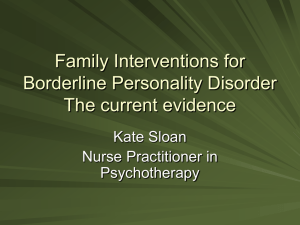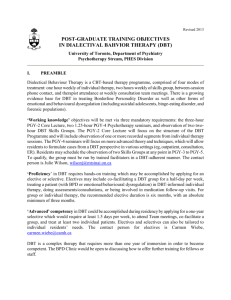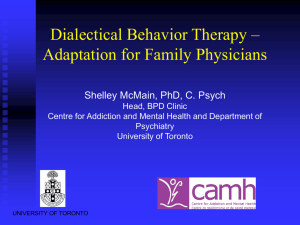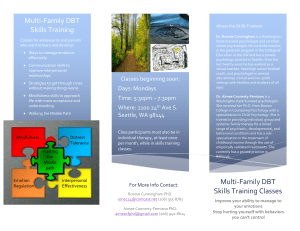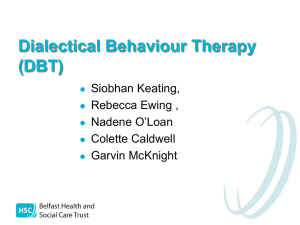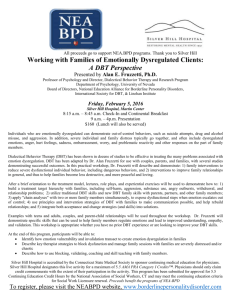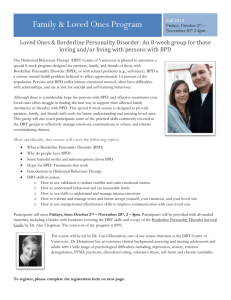The Gwylfa Therapy Service - Scottish Personality Disorder Network
advertisement
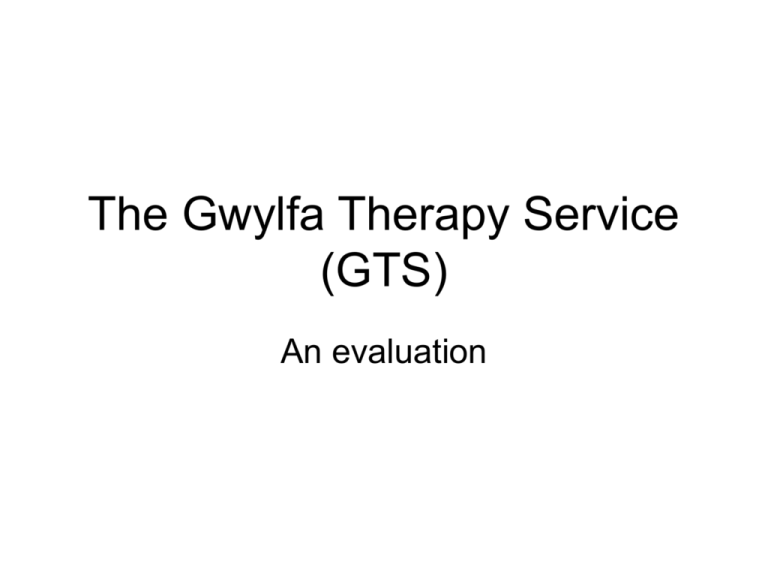
The Gwylfa Therapy Service (GTS) An evaluation What is the GTS? Specialist Service for people with a Personality Disorder. Based in St. Cadoc’s Hospital, Caerleon. Service started end of February 2005 Provided by Gwent Health Care Trust. GCHT serves a population of approx. 600,000 in South East Wales. Who are the GTS? – Consultant Clinical Psychologist (1WTE) – Psychiatric Nurse (1WTE) – Principal Clinical Psychologist (1WTE) – Consultant Psychotherapist/Psychiatrist (0.4 WTE) – PhD Research Student (1 WTE) – Administrator (0.5 WTE) What does the GTS do? Provide consultation/ advice/ support/ supervision service to CMHT’s. Implement a clinical service for a small number of severely distressed patients who cannot be managed at CMHT level. Provide Assessment/gatekeeping to patients who are referred to Out of Area PD Services. Provide training and staff development PERSONALITY DISORDER SERVICE WHAT WORKS? Dynamic psychotherapy, DBT, Therapeutic Community Tx, Schema Focused Tx. CT and CAT show some promise. Pharmacotherapy - target specific problem areas - Soloff’s Medication Algorithm: Cognitive/perceptual Affective Impulse dyscontrol No magic bullet Drugs alone insufficient to treat PD GWYLFA THERAPY SERVICES SKILLS BASE. • Dialectical Behaviour Therapy. • Psychoanalytic Psychotherapy. • CBT. • CAT. • Individual and group work. • Staff supervision and consultation. PERSONALITY DISORDER SERVICE WHAT WORKS? Main features of effective treatment: Well structured. Apply effort to enhance compliance. Clear therapeutic focus. Theoretically highly coherent to P and T. Relatively long term. Encourage powerful attachment relationships (which are worked within). Well integrated with other services. Why Evaluate? • Growing evidence basis - no clear evidence of outcome of any one approach. • New developing field. • Formulation driven clinical service requires measurement on single case basis. • Are GTS outcomes similar to that in controlled group studies – different therapists, patients, service context etc? • High intensity work – demonstrate worth. • All new PD services need built in ongoing evaluation. AIM OF RESEARCH • To develop methodologies, measures, methods of analysis etc. • To share these with other practitioners. • To develop our clinical service. • Ongoing work. • Progress report. • Further analyses to be conducted. Evaluation of the GTS. • 3 areas of research:– Part 1 - Patient centred evaluation. – Part 2 - Service evaluation. – Part 3 - Theory driven research (not discussed here). Part 1 - Patient Centred Evaluation • Part 1a – Clinical analysis of effectiveness of DBT. • Part 1b - Comparison between those who remain in therapy with those who drop out. Part 2 - Service Evaluation • Part 2a - Examination of what community mental health teams want from the GTS consultation service and what the GTS feels it can provide. • Part 2b - Examination of nursing staff attitudes towards patients with personality disorder. • Part 2c - Examination of patients views of services they have had contact with. Part 3 - Theory based Research • Part 3a - Examination of relationship between emotional dysregulation, cognitive dysregulation and features of BPD. • Part 3b - Examination of relationship between Emotional Intelligence, Alexithymia and features of BPD. Part 1a - Clinical analyses • 2 principle questions:– Can we develop an effective method of evaluating clinical change over long-term inclusion in DBT? If yes:– To what extent is DBT helping those who enter therapy? DBT with the GTS • One-to-one weekly therapy session. • Weekly skills group teaching 4 skills modules (takes approx 6 months):• Mindfulness (repeated between each module). • Distress tolerance. • Interpersonal effectiveness. • Emotion regulation. Clinical analyses-data collection • Data gathered from 3 sources:– Psychometric measures, completed every six months over course of DBT. – Daily diary cards, completed by patient outside of therapy setting. – Service user data, drawn from patient’s records. Rationale for choice of Psychometric measures • Linehan (1993) reorganised the DSM criteria of BPD into 5 areas of dysregulation:– Emotional. – Cognitive. – Behavioural. – Self. – Interpersonal. Psychometric measures • We chose measures that:– Broadly map onto the 5 areas of dysregulation as defined by Linehan (1993). – Specifically they focus on therapy targets as agreed by each patient and their clinician. Psychometric measures • Novaco Anger Scale and Provocation Inventory (NAS-PI; Novaco, 2003):– – – – – Disrespectful treatment. Unfairness. Frustration. Annoying traits of others . Irritations. Psychometric measures • Brief Symptom Inventory (BSI; Derogatis, 1993):• • • • • • • • • Somatisation. Obsessive compulsion. Interpersonal sensitivity. Depression. Anxiety. Hostility. Phobic anxiety. Paranoid ideation. Psychoticism. Psychometric measures • Inventory of interpersonal problems (IIP; Horowitz et al., 1988):• • • • • • • • • Domineering/Controlling Vindictive/self centred Cold/distant Socially inhibitted Non-assertive Overly Accommodating Self Sacrificing Intrusive/needy Total IIP Psychometric measures • Social Problem-Solving Inventory – Revised (SPSI-R; D’Zurilla, Nezu, & Maydeu-Olivares, 2002):• Positive Problem Orientation. • Negative Problem Orientation. • Rational Problem Solving. • Impulsivity/Carelessness Style. • Avoidance Style. • SPSI Total. Diary Card Data • Normally completed by patient daily outside of therapy setting but can be completed during weekly session • Can be idiosyncratic but normally covers range of areas:– – – – – Urges – self harm*, suicide* Emotions – pain*, fear*, sadness*, shame* & anger* Experiences - active passivity*, dissociation*, crisis*, self hate* Drug use – prescription, OTC, illicit Skills use – were they used, did they work, to what extent? *(Clients use a 0-5 rating scale of severity/intensity). Service User data. • Number of contacts with services. • Number of incidents. • Number of hospital admissions. • Number of days spent in hospital. Study designs and analyses • Psychometric measures:– Repeated measures design looking at pre and post treatment differences. – Analysed using Clinical Significance Calculations (Jacobson & Truax, 1991). Study designs and analyses • Diary card data:• Multiple baseline design. • Plan to analyse using the Conservative Dual Criteria Approach (Fisher, Kelley, & Lomas, 2003). Study designs and analyses • Service User data:• Repeated measures design • Plan to analyse using ANOVA Analyses of Psychometric measures – Clinical significance • Statistical significance versus clinical significance (meaningful change). • Statistical significance – reveals if significant change has occurred or not. • Not useful if statistical change (or lack of) has no meaning to patients situation. • Clinical significance or meaningful change – although not necessarily statistically significantis change that has large implications for a patients daily functioning and/or quality of life. How to determine clinical significance • Jacobson & Truax propose 3 ways:1. A post treatment score on any given measure must fall within 2 standard deviations of a functional population norm for the measure. 2. A post treatment score on any given measure must fall beyond 2 standard deviations of a non-functional population for the measure. 3. Ideally both of the above. Because overlap of SD’s can occur use equation – on next slide. When SD’s are large – advised to use 1 SD. Clinical Significance equation • Multiply the SD of a functional population mean by the dysfunctional population mean. • Next:• Multiply the SD of a dysfunctional population mean by the functional population mean • Next:• Add both sums together, then • Divide this figure by:• SD of functional population + SD of dysfunctional population. Clinical Significance equation (SD of f’nal pop x M of dysf’nal pop) + (SD of dysf’nal pop x M of f’nal pop) SD of f’nal pop + SD of dysf’nal pop • Due to number of scales per measure, gaining meaningful data that is easy to interpret is difficult. • Therefore:• Only Total scales were used to determine there has been any clinically significant change. Example of how to report clinical Significance Table 1 Pre and post DBT scores for NASPI total scale • • • • Client Pre-DBT Post-DBT 1 124 85* 2 99 80* 3 83† 99> 4 85† 84 5 95 113> 6 101 85* 7 65† 62 8 111 119> * Clinically significant change to within 2 standard deviations of the functional population mean. ** Clinically significant change to within one standard deviation of the functional population mean † Client score fell within functional population range prior to treatment > Clinically significant change to beyond functional population range Example of how to report clinical Significance Table 2. Pre and post DBT scores for the IIP total scale Client Pre – DBT Post - DBT 1 126 40** 2 145 146 3 89 58 4 120† 121 5 159 91** 6 168 163 7 57† 79 8 123 153 Examples of how to report clinical Significance Table 3 Pre and post DBT scores for the BSI total scale Client Pre -DBT Post DBT 1 3.41 3.18 2 3.46 3.52 3 1.67 † 2.16 4 1.94 2.03 5 2.07 0.39** 6 3.20 2.80 7 1.57† 0.96 8 2.28 2.86 Examples of how to report clinical Significance Table 4 Pre and post DBT scores for the SPSI total scale Client Pre -DBT Post DBT 1 3.41 3.18 2 3.46 3.52 3 1.67 † 2.16 4 1.94 2.03 5 2.07 0.39** 6 3.20 2.80 7 1.57† 0.96 8 2.28 2.86 Diary card analyses – Progress Report. • The Conservative Dual Criteria approach (CDC; Fisher et al. 2003):– Designed for the analysis of single case data. – Accounts for autocorrelation within data. – A baseline mean and regression line is computed. – The standard deviation of the baseline mean is then computed and multiplied by .25. – This value is added to the baseline mean line and the regression line. CDC continued • The adjusted mean lines and trend lines are plotted in the intervention phase. • Any intervention score that falls above or below both of the lines is considered a success. • Autocorrelation increases the risk of a type I error, but this can be counterbalanced by; • Only counting an outcome as a success if it falls above or below both lines, then raising these lines by .25 standard deviations • The number of successes in the intervention phase is compared to the number expected by chance. A significant change at the <.05 level can also be established Applying CDC to diary card data • Diary cards cover range of areas; – Urges – self harm, suicide. – Emotions – pain, fear, sadness, shame, anger. – Experiences - active passivity, dissociation, crisis, self hate. – Drug use – prescription, OTC, illicit. – Skills use – were they used, did they work, to what extent? – But this creates many variables to be analysed. Simplification • Creating many variables prevent meaningful interpretation, therefore scores were grouped into 4 domains:– Urges. – Actions. – Emotions. – Skills – (if used and were helpful). Simplification • In order to map diary card domains onto skills modules a mean score was calculated for each module. • Each was then graphed for visual inspection. 44 weeks in DBT (patient 1) 22 weeks of DBT (patient 2) 57 weeks of DBT (patient 3) 48 weeks of DBT (patient 4) 70 weeks of DBT (patient 5) 92 weeks of DBT (patient 6) 56 weeks of DBT (patient 7) 122 weeks of DBT (patient 8) The next step • To apply the CDC to predetermined modules that map onto the diary card data that we expect to change in accordance with the module. • For example is there a reduction in scores on emotional dysregulation when undertaking emotion regulation module? Service user data • Most interested in number of hospital admissions. • Length of stays in hospital. • Hypothesis is that length of DBT will reduce both of the above. • All patients service user data was examined for approximately 1 year prior to entering therapy and for duration of therapy. Service user results • Patient 1 entered therapy march 2006 and had no admissions in 12 months prior to over duration of therapy 20 Value Patient 2. Entered therapy July 2007 Number of admissions Number of days in hospital 30 10 0 7 b0 Fe 8 n0 Ja 7 0 ec D 7 0 ov N 07 ct O 7 0 ep S 7 0 ug A 7 l0 Ju 7 n0 Ju 7 0 ay M 07 pr A 7 0 ar M 7 b0 Fe 7 n0 Ja 6 0 ec D 6 0 ov N 6 0 ct O 6 0 ep S 6 0 ug A 6 0 ly Ju 06 ne Ju Month 20 Value Patient 3. Entered therapy June 2007 Number of admissions Number of days in hospital 30 10 0 7 b0 Fe 8 n0 Ja 07 ec D 7 0 ov N 7 0 ct O 7 p0 Se 7 g0 Au 7 l0 Ju 7 n0 Ju 07 ay M 7 r0 Ap 07 ar M 7 b0 Fe 7 n0 Ja 06 ec D 6 0 ov N 06 ct O 6 p0 Se 6 g0 Au 06 ly Ju 06 ne Ju 06 ay M 6 r0 Ap 06 ar M 6 b0 Fe Month Patient 4. • Entered therapy March 07 • 1 admission April 06 for 3 days Patient 5. • Entered therapy November 06 • No admissions except 2 admissions for 2 days in February 2008 15 Value Patient 6.Entered therapy October 2005 Number of admissions 30 Number of days in hospital 25 20 10 5 0 feb08 jan08 dec07 nov07 oct07 sep07 aug07 jul07 jun07 may07 apr07 mar07 feb07 jan07 dec06 nov06 oct06 sep06 aug06 jul06 jun06 may06 apr06 mar06 feb06 jan06 dec05 nov05 oct05 sep05 aug05 jul05 jun05 may05 apr05 mar05 feb05 jan05 Month 20 Value Patient 7. Entered therapy February 2005. No further admissions since Jun 2006 Number of admissions Number of days in hospital 30 10 0 6 p0 se 6 g0 au 6 l0 ju 6 n0 ju 06 ay m 6 r0 ap 6 0 ar m 6 b0 fe 6 n0 ja 5 c0 de 5 v0 no 5 t0 oc 5 p0 se 5 g0 au 5 l0 ju 5 n0 ju 05 ay m 5 r0 ap 5 0 ar m 5 b0 fe 5 n0 ja 4 c0 de 4 v0 no 4 t0 oc 4 p0 se 4 g0 au 4 l0 ju Month 15 Value Example of graphed service use data for patient 8. Entered therapy January 2005 Number of admissions Number of days in hospital 30 25 20 10 5 0 feb08 jan08 dec07 nov07 oct07 sep07 august07 july07 june07 may07 apr07 mar07 feb07 jan07 dec06 nov06 oct06 sep06 aug06 jul06 jun06 may06 apr06 mar06 feb06 jan06 dec05 nov05 oct05 sep05 aug05 jul05 jun05 may05 apr05 mar05 feb05 jan05 dec04 nov04 oct04 sep04 aug04 jul04 jun04 may04 apr04 mar04 feb04 jan04 Month Next step • To compare particular time phases to establish significant or non-significant reductions in hospital admissions and lengths of stay. In summary • Clinical Significance calculations show that there is significant movement of scores for some of our DBT patients. • Visual inspection of diary cards suggests that urges to self harm emotional dysregulation & acts of self harm reduce whilst skills for managing emotional dysregulation improve, for some patient in particular modules. But we need to apply CDC to test for significance. • Visual inspection of service user data indicates a reduction in hospital stays but again this needs to be tested for significance. Part 1b Part 1b - Comparison of those who discontinue therapy with those who continue. AIM • To identify reasons why patients discontinue therapy. • Why? • To channel otherwise limited resources towards those with whom therapy might prove more effective. Measures • Diagnostic measure - International Personality Disorder Examination- DSM-IV interview (IPDE; Loranger, 1999). • Motivational Measure - Treatment Motivation Questionnaire (TMQ; Ryan, Plant, & O’Malley, 1995). examines internal and external levels of motivation to enter therapy. • Cognitive measure – Social Problem solving inventory (SPSI). Participants • 14 female patients who entered therapy between (mean age - 36.90). • 7 of whom continued therapy for up to 9 months at the time the study commenced (mean age - 40.43). • 7 of whom discontinued after no longer than 4 months (mean age – 33.29). Personality Diagnosis • Tyrer and Johnson (1996) proposed an empirically-based system for classifying the severity of PD based upon the number of conditions diagnosed and whether or not these are from the same cluster. A simple PD is PD in one cluster only, whereas a complex PD is PD’s from more than one cluster. Personality Diagnosis Continuers Discontinuers P1 - BPD P8 - BPD, obsessive/compulsive PD P2 - BPD P9 - BPD, Paranoid, Histrionic, Dependant, Avoidant P3 - BPD P10 - BPD, Avoidant P4 - BPD P11 - BPD, Dependant, Avoidant, Schizoid P5 - BPD P12 – BPD, Paranoid, Schizoid, Histrionic, Narcissistic, Avoidant, Dependent P6 - BPD, Impulsive PD P13 – BPD, Impulsive, Avoidant, Dependant P7 - BPD, Avoidant PD P14 – BPD, Histrionic, Avoidant, Obsessive/compulsive SPSI results Continued Discontinued MannWhitney U * Positive Problem Orientation 7.16 (3.31) 5.57 (4.35) -0.57 Negative Problem Orientation 26.33 (5.68) 31.71 (5.18) -1.08 Rational Problem Solving 42.50 (18.49) 32.57 (21.46) -1.00 Impulsive/careless Style 16.01 (7.64) 20.14 (10.82) -0.94 Avoidant Style 13.33 (7.42) 16.14 (4.59) -0.43 * All non significant Motivation (TMQ) • Continuers of therapy reported significantly more internal reasons to be in therapy compared to discontinuers. For example – personal desires to change • Discontinuers of therapy reported significantly more external reasons to be in therapy compared to continuers. For example, pressures from outside agencies such as friends families CPN’s etc. Service use over the 9 months • Continuers • 4 patients admitted • Discontinuers • 6 patients admitted • 16 total admissions • 17 total admissions • 151 bed days • 379 bed days • Total cost = £39,197 • Total cost = £122,444 Tentative Interpretation • Those with simple PD are more likely to remain in therapy compared to those with complex PD. • Those with high levels of internalised motivation more likely to remain in therapy compared to those with high levels of externalised motivation. Part 2 Service evaluation Part 2 – Service Evaluation • Part 2a - Examination of what community mental health teams want from the GTS consultation service and what the GTS feels it can provide (Consultation service evaluation). • Part 2b - Examination of nursing staff attitudes towards patients with personality disorder using Attitude Towards Personality Disorder Questionnaire (APDQ; Bowers 2004). • Part 2c – Delphi survey of patients views of services they have had contact with. Part 2a Consultation service evaluation. Consultation service evaluation • Aims:– To identify main problems CMHT experiences with referred patients. – The type of support the CMHT needs. – Increase effective dialogue with CMHT to increase more effective time management. – Identify pathways into increasing staff awareness of PD. Consultation service evaluation • Constructed a pilot questionnaire to establish what information would be helpful to GTS upon a patient’s referral to service. • Gathered information via telephone. Method • 2 Psychiatrists, 2 Clinical Psychologists, 6 Nurses and 4 CPN’s were recruited. • All had direct contact with GTS. • 3-12 months of consultation. • Data broken down into themes and subthemes via qualitative analysis. Results • Staff descriptions of patients:• Unpredictable. • Difficult. • Challenging. • Needy. • Friendly. • Pleasant. Results • Feelings elicited working with BPD:• Frustrated. • Helpless. • Anxious. • Angry. • Curious. • Interested. Results • Reasons for contacting GTS:• Can’t progress with patient • Lack strategy • Need fresh ideas • Unstructured approach Results • Main problems experienced with patient:• Suicidal Ideation. • Self-Harm. • Substance misuse. • Non-compliance. Results. • Staff reported mainly behaviour centred problems in patients with PD such as self harm, substance abuse and non-compliance. • Staff report feeling frustrated and helpless when working with patients with features of BPD. • Staff also reported feeling unable to progress with patients with BPD and experiencing a lack of coordination at CMHT level. Results • What CMHTs ask from GTS:• Help to reduce negative behaviours. • Increase both staff and patient insight. • Increase patient engagement with CMHT. • Skill up staff through training (DBT, CBT etc). • Support, guidance and supervision. Consultation Service evaluation - Some comments – First class service - staff helpful. – “Good so far”. – Patient adjustment improved during/ after. – Service come to late for some - but inevitable. – Consultation process too unstructured. – Referral process could be managed better. – Want Gwylfa to take on complete care - don’t want joint working/ consultation. – Referral process too slow, lengthy & service not responsive enough. Conclusions • GTS needs to implement training to allow more autonomy. Such training could include motivational interventions, crisis management, coping with difficult behaviours, DBT and CBT training. • Teams need coherent treatment strategies and practice guidelines for handling difficult behaviours, such as self harm or suicidal ideation. Part 2b Nursing staff attitudes towards personality disorder. Nursing staff attitudes towards personality disorder • Aims: – Assess CMHT staff attitudes towards and willingness to work with patients with PD. – Examine how an interest in PD improves attitudes. – Compare Trust staff to other groups working with PD and offer reasons why different levels of attitude exist. Method Sample:88 nurses who had not volunteered for PD awareness training. 29 nurses who had volunteered. Compared with:645 nurses in high security setting. 76 nurses who volunteered to work on DSPD unit. 166 non volunteer nurses on DSPD unit. 55 prison officers working on a DSPD unit. (Carr-Walker, Bowers, Callaghan Nijman & Paton, 2004) Method • Measure:Attitude Towards Personality Disorder Questionnaire (APDQ; Bowers et al. 2000). 37 item measure with 5 scales: enjoyment, security, acceptance, purpose, enthusiasm. Method • Procedure:– Non volunteer group: Researcher visited 12 CMHTs within the Trust with request to completed APDQ in MDT. – Volunteer group: Facilitator informed volunteers that completion of APDQ formed part of their inclusion in workshop. Method • Analyses:– Non parametric comparisons looking at how:– Those who volunteered to PD awareness workshop differ in attitude to those who did not – T-tests:– Collapsing above groups into one and comparing with samples taken from CarrWalker et al. (2004) Results • Compared to non-volunteer group, nurses who volunteer for PD awareness workshop reported significantly higher levels of:Enjoyment. Security. Acceptance. Purpose. But not enthusiasm. Results • Trust nurses were compared with Prison officers, the latter of whom reported significantly higher levels of:– Security. – Acceptance. – Purpose. – Enthusiasm. Results • All Trust nurses were then compared with nurses in high security setting. • Nurses in high security setting report significantly higher levels of:– Enjoyment. – Security. – Acceptance. – Purpose. Results • Trust nurses were compared with nurses who volunteer to work in DSPD unit the latter of whom report significantly higher levels of:– Security. – Acceptance. – Purpose. Results • Trust nurses were compared with nurses who did not volunteer to work on DSPD unit but did so anyway. • DSPD nurses report significantly higher levels of:– Enjoyment – Security – Purpose Conclusion • Nursing staff require help to feel safe, more accepting and more purposeful with patients PD. • Next step is to design suitable training and evaluate its effectiveness. • Aim to develop training that changes knowledge, attitudes and skills and eventually how this benefits the patients. Part 2c Delphi survey of patients views of services they have had contact with. The Delphi survey • Aim:• To gather the views of service users. • Establish which areas of mental health and related services need support and guidance that may provide better support for patients in crises. • Provide a more seamless transition from first contact to inpatient support. Broad Findings • Police – perceived as kind and helpful but not responsive to needs. • General practitioners – generally understanding but pressed for time and can misunderstand level of crises. • General hospital staff – disrespectful, disdainful and dismissive. • Psychiatric hospital staff tend to be more helpful but there is room for improvement. • Psychiatrists and Psychologists were rarely mentioned but were satisfactory. Broad Findings • GTS generally perceived as:• Respectful. • Supportive. • Professional. • More details can be found in paper below. References • Webb, D., & McMurran, M. (2007). Nursing staff attitudes towards patients with personality disorder. Personality and Mental Health, 1, 154-160. • Webb, D. & McMurran, M. (2008). A Delphi survey of Patients’ views of services for borderline personality disorder: A preliminary report. Personality and Mental health, 2, 17-24. • Webb, D., & McMurran, M. (2008). A comparison of women who continue and discontinue Dialectical Behaviour Therapy-based treatment for borderline personality disorder. Personality and Mental Health. (paper submitted for review). • Webb, D., & McMurran, M. (2008). Alexithymia, Emotional Intelligence, and borderline traits in young adults. Personality and Mental Health (Paper in press).
